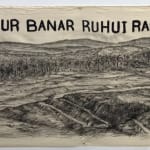Maryanto
Each province in Indonesia carries their own unique saying, mostly written in antiquated vernacular. For Becoming Palm (2023), Maryanto borrows the vocabulary from ancient Borneo literature that is no longer used in modern day. “Bujur banar ruhui rahayu” loosely translates to “it is really peaceful and serene-harmonious” and can be understood as a saying in East Kalimantan to describe the serene beauty of the environment. Yet its regional symbol only features the latter words ‘ruhui rahayu’. The story behind its abridged adaptation was said to be that the region’s leader had studied in West Java (Sudan) and ‘bujur’ means ‘ass/arse’ in Sudanese.
These words are placed in stark contrast to the scenery Maryanto has depicted, which reveals the reality of the Kalimantan forests and its extensive devastation. He imitates the Mooi Indie style of painting, which was the à la mode to promote the scenic landscapes of Asia before photography was popularised and is now often seen in the national collections in Europe. It draws a connection to the Dutch colonial period that had first introduced the development of plantations, transmigration, and land ownership in Indonesia, where postcards of these scenic landscapes were often sent back home in request for more financial assistance to develop the plantations. Lamenting the irrevocable ruin of the forests in present-day, Maryanto subverts this idea as a plea for corporations to stop pumping investments to its lands. He recalls a Javanese proverb that encapsulates the struggles of the community in its earnest pursuit for tranquillity, fertility, prosperity, and nobleness: gemah ripah loh jinawi.



